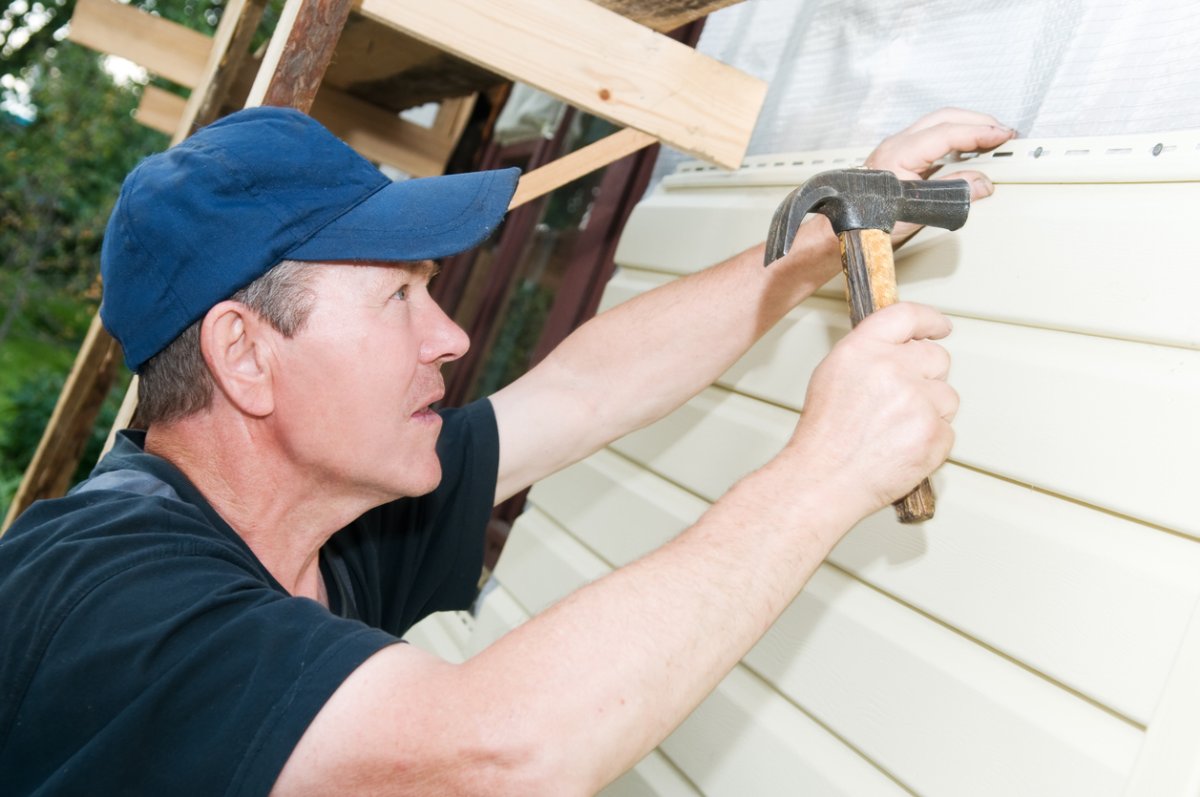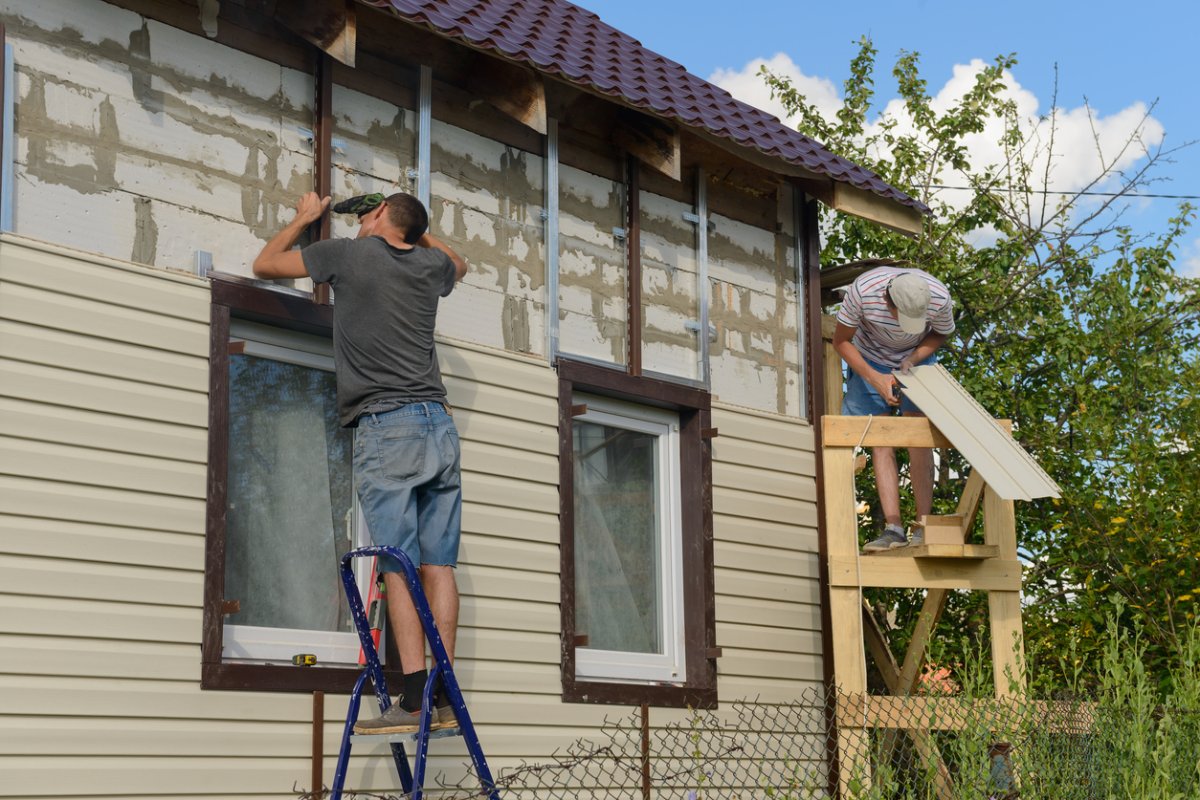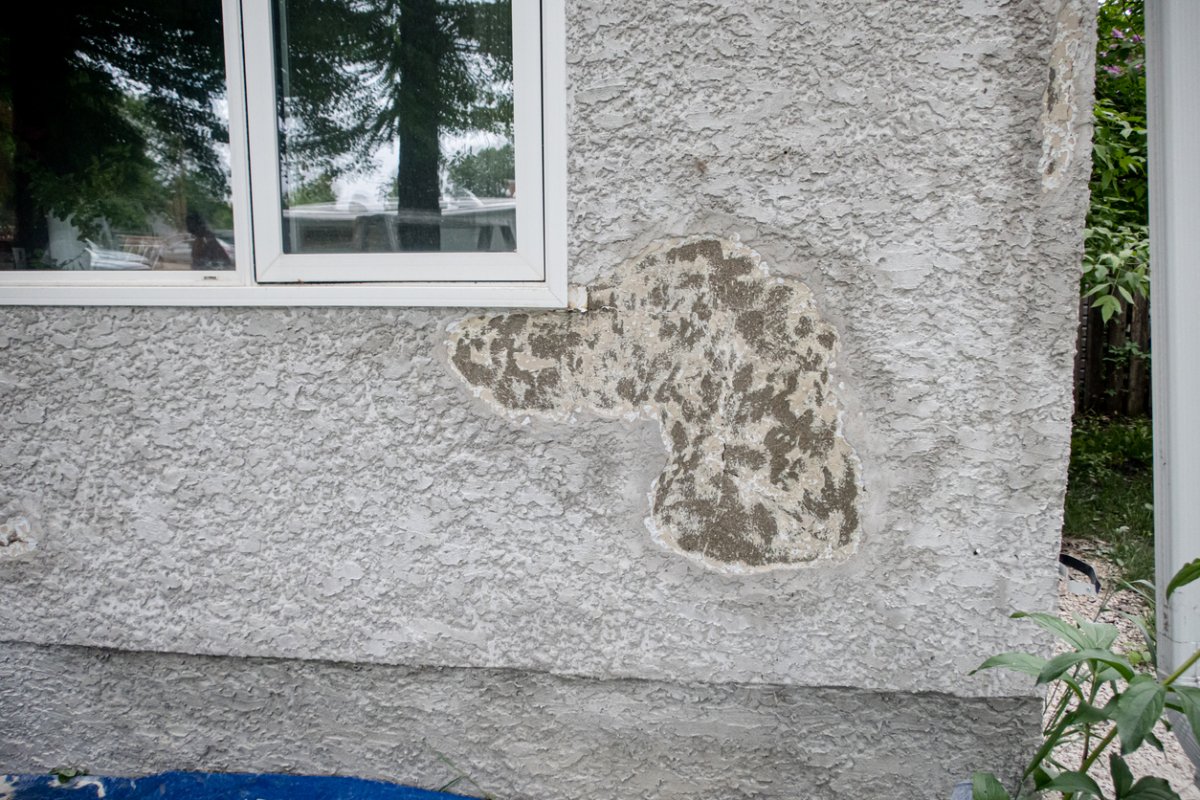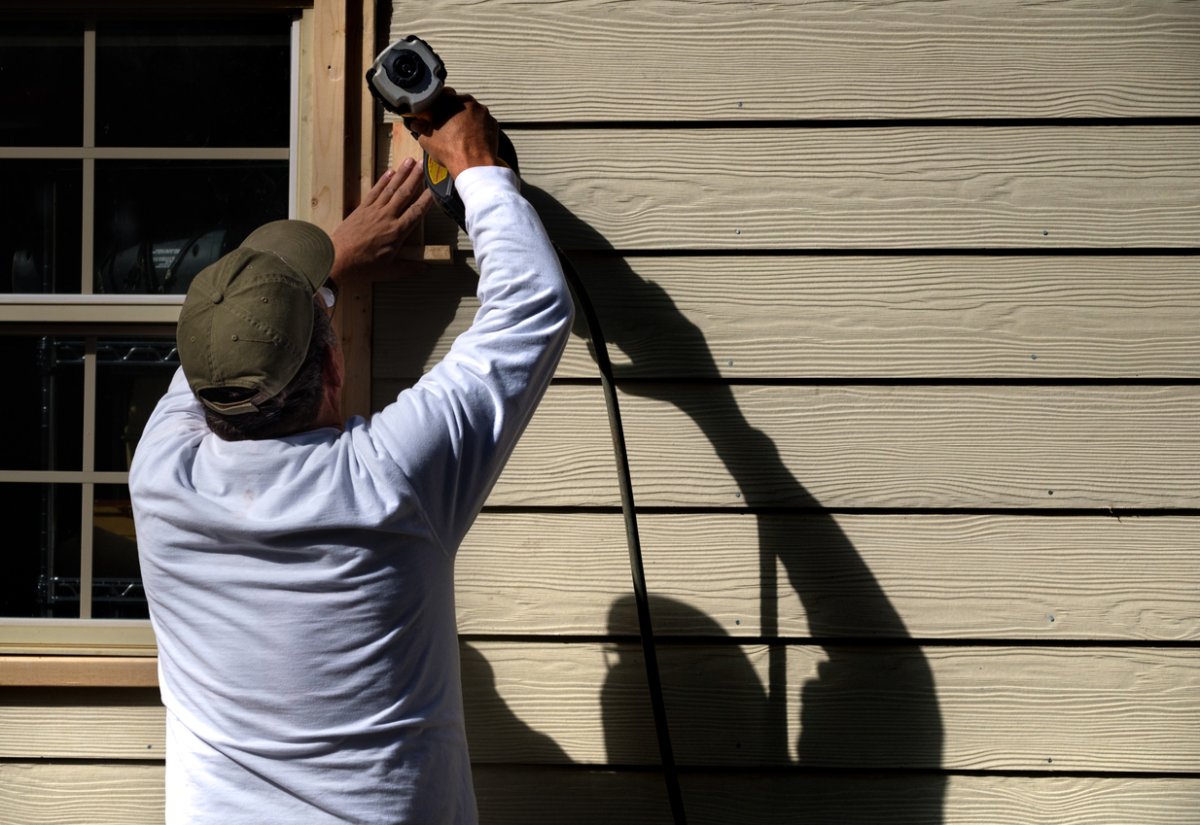

We may earn revenue from the products available on this page and participate in affiliate programs. Learn More ›
Highlights
- Most siding repair costs range from $354 to $1,442, but the average cost is $884.
- The size of the home, type of siding, type and extent of damage, and current labor rates are some of the primary factors that determine the cost to repair siding.
- It’s time to repair or replace siding when there’s visible damage, peeling or bubbling paint; excessive mold growth; or increased energy bills.
- Minor cracks can be repaired with DIY kits, but most siding repairs are best left to a pro who has the tools and experience to ensure the home’s exterior is fully protected against bad weather.
When a home’s exterior siding is in good condition, the entire house looks more polished. If the siding is damaged, then repairing it quickly is essential to improve the appearance of the home and prevent more problems like mold growth. Siding repair could consist of patching holes, fixing dents, cleaning mold, or removing and replacing the damaged portions.
The average siding repair cost will vary depending on the extent of the damage and the type of siding material. Wood siding repair costs, for instance, usually have a higher price point than vinyl siding repair costs. According to Angi, the national average cost for siding repair is $884, but total costs can range from $354 to $1,442.

Key Cost Factors
Exposure to the elements, damage, age, and normal wear and tear are all reasons that siding may need to be repaired. The factors that impact the cost to repair siding include the type of necessary repairs, the size and height of the house, the type of siding, the extent of the damage, labor, and any required permits. Analyzing these factors can help homeowners get an idea of the cost of their siding repair project.
Repair Size and Type
The size of the damaged area will determine how much siding to repair or replace. For that reason, smaller repair areas will likely cost less than large sections of siding. The type of damage can also impact the final cost, as the tools, materials, and labor hours will vary to repair water damage, mold, cracks, warped siding, or other types of damage. To replace a large section of siding, the cost falls between $2 and $50 per square foot. If the area to be repaired is small, a contractor may charge a minimum fee to cover their time and costs.
House Size and Height
The size of the house will influence the cost if the damage is a result of widespread water damage, hail, high winds, or other issues that have affected a large part of the house. Another factor to consider is the location of the damage. If repairs are needed on the upper level of the home, the contractor may increase their price by 25 percent to 50 percent to account for the additional labor on a more complicated project.
Siding Type
One of the most popular siding choices is vinyl siding, since it’s low-cost and versatile. Fiber cement, wood, clapboard, and aluminum also sit on the lower price range, with brick, stucco, and stone falling on the higher end of siding repair costs.
| Type of Siding | Average Cost (Materials and Labor) |
| Aluminum | $5 to $7 per square foot |
| Brick | $6 to $18 per square foot |
| Clapboard | $5 to $10 per square foot |
| Fiber cement | $3 to $11 per square foot |
| Stone | $10 to $30 per square foot |
| Stucco | $9 to $50 per square foot |
| Vinyl | $2 to $4 per square foot |
| Wood | $4 to $13 per square foot |
- Aluminum. This material may be less popular than it once was, but it’s still an option to consider since it resists rot and rust. It can be prone to dents and fading over time and may not be as energy efficient as other types of siding. Aluminum siding repairs cost between $5 and $7 per square foot.
- Brick. A brick home is one of the most classic home styles, but it can be expensive to repair the exterior since brick and mortar are labor intensive to work with. Another consideration is whether the siding is true brick or brick veneer, as the type will also impact the cost of repairs. The cost to repair brick siding typically falls between $6 and $18 per square foot. Costs for tuckpointing (repairing the mortar) average $500 to $2,500, and costs for repairing brick veneer are between $7 and $14 per square foot.
- Clapboard. This siding is made of long pieces of wood that overlap and looks similar to vinyl siding as opposed to a shiplap style. Clapboard is durable but will require caulking and painting every few years. It costs $5 to $10 per square foot to repair.
- Fiber cement. With a mid-range price point, fiber cement is low maintenance and highly durable. The mix of cement, sand, and wood fibers (also called cellulose) creates a sturdy siding that resists insects, rot, fire, dents, and cracks. It’s available in a wide range of styles and colors. Fiber cement siding repairs cost about $3 to $11 per square foot.
- Stone. Stone siding repairs fall on the higher end of the price range: between $10 and $30 per square foot. Part of the reason is that stone siding is very heavy and expensive to install and repair. Stone veneer siding repairs will cost about the same as repairs for actual stone.
- Stucco. A classic option for siding is stucco. It’s made from a mix of cement, sand, and water that creates a textured surface. While it can be painted any color, white is often the color of choice. Stucco repairs can be costly, falling between $9 and $50 per square foot. This material is best repaired by a professional to ensure the new stucco blends in with the original.
- Vinyl. Traditional vinyl siding is one of the most common types of siding since it’s available in a wide variety of colors and textures. It’s also durable and resists rot while requiring minimal maintenance. If homeowners need to remove large sections and replace them with new siding, they’ll likely find a vinyl color to match, but they’ll have to take into account any fading of the original siding. Vinyl siding repairs cost between $2 and $4 per square foot.
- Wood. Most wood siding is typically made from cedar, but it can also be made from pine, cypress, or other suitable wood. Cedar is naturally resistant to insects and rot, so while it will need to be painted or stained and sealed periodically, its natural properties help it last longer. Wood siding repair costs typically fall between $4 and $13 per square foot.
Damage Extent
The extent of the damage will factor heavily into the total cost to repair house siding. A small hole or dent in vinyl or aluminum siding can be patched or fixed relatively quickly. Siding hole repair averages between $50 and $100, but a vinyl siding repair kit may cost only around $20. More extensive damage that requires removing and replacing large sections will cost quite a bit more, and damage to brick or stucco siding will also come at a higher price point.
Labor and Permits
Siding repair companies often charge by the job, but it’s possible that they’ll charge by the hour. Most siding repair labor costs fall between $40 and $90 per hour. Factors that affect labor costs include the size and location of the damage and the type of material being repaired. A siding contractor will also know if permits are needed and who will pull them.

Additional Costs and Considerations
Some additional considerations when homeowners are determining siding repair cost include existing siding removal and disposal, price differences in repairing vs. replacing the siding, insulation installation, and asbestos removal. These factors can add to the total cost of the project but may not apply to each situation.
Existing Siding Removal and Disposal
To remove the damaged siding and dispose of it, contractors typically charge between $0.25 and $2 per square foot. This cost, along with the actual repair and cleanup, will be part of the overall quote. If homeowners are doing the work themselves, they’ll save on removal costs but may still have to pay junk removal costs or a dumpster costs depending on how much siding they’re removing.
Repair vs. Replacement
Choosing between house siding repair and replacement depends on a few factors. If the damage is minimal, then repairing the siding with a patch or dent removal kit can save homeowners some money. But if the damage is extensive or covers a larger area, it may be necessary to remove the siding and house wrap (weather barrier) and replace them entirely. When homeowners are choosing a siding material, it’s important to take siding costs and the lifespan of the material into consideration. For instance, vinyl siding costs less than fiber cement, but it may not last as long.
The age of the siding also plays into the decision to replace or repair. Vinyl, aluminum, and wood siding can last up to 40 years, while fiber cement siding, brick, and stone can last 50 years or more. Considering the age of the siding and extent of repairs can help homeowners determine if they need repair or replacement. For instance, if the siding is in overall good condition and only 20 years old, repair may be the best choice. But if the siding is older and starting to show wear or damage in multiple areas, it might be time to replace siding on the entire home.
Insulation Installation
According to Jay Sander of Maryland Contractors in Baltimore, Maryland, “Unseen issues like damaged insulation or structural problems can increase the overall cost by 10 percent to 20 percent, depending on the severity and necessary remediation.” Protecting the house with house wrap to insulate and guard against moisture can add between $0.50 and $2 per square foot to the project.
Asbestos Removal
Homes built before 1978 may have asbestos siding or insulation, which can be hazardous when disturbed. The contractor might conduct an asbestos test, which can cost between $230 and $781. Asbestos siding removal costs can be up to $10 per square foot since the process requires specialized equipment and additional safety precautions.
Additional Repairs
Any additional repairs can include crack filling, damaged board replacement, hole repair, or water damage repair, among others. Depending on the age of the siding and the amount of care and maintenance it’s received, other issues may reveal themselves as siding is removed.

Cost by Type of Repair
The type of siding repair and total repair time will also affect the overall cost of the project. Some repairs, like filling minor holes or fixing a small dent, will cost less. On the other hand, damaged board replacement and water-damaged siding repair can result in significant costs. Waiting to repair the problem rather than addressing it immediately can increase the total cost of the repairs since other areas of the house can become vulnerable to weather damage.
| Type of Siding Repair | Average Cost (Materials and Labor) |
| Crack filling | $50 to $800 |
| Damaged board replacement | $1 to $18 per square foot |
| Dry rot repair | $100 to $2,000 |
| Hole repair | $50 to $200 |
| Mold remediation | $10 to $25 per square foot |
| Painting | $1 to $5 per square foot |
| Water damage repair | $25 to $600 |
Crack Filling
Sometimes crack filling costs can add up depending on the severity of the cracks. Typically it will cost between $50 and $800 to repair cracks. However, if the cracks affect a large area of the siding, the entire section may need to be removed and replaced, which can drive up the total cost. DIY repair kits are available and can help prevent the cracks from spreading for a while.
Damaged Board Replacement
In some cases, a damaged board or piece of siding will be too damaged to repair. Damaged board replacement costs will vary depending on the type of siding.
| Type of Siding Material | Average Cost (Materials and Labor) |
| Aluminum | $3 to $18 per square foot |
| Brick | $3 to $11 per square foot |
| Fiber cement | $1 to $10 per square foot |
| Vinyl | $1 to $7 per square foot |
| Wood | $1 to $12 per square foot |
Dry Rot Repair
Dry rot may not be apparent until pieces of siding are removed. If the homeowner or contractor finds dry rot, repairs can cost between $100 and $2,000. The contractor should also determine the cause of the rot, which can help determine if other repairs like plumbing repairs or termite extermination is necessary. Plumbing repairs average $325, depending on the type of damage and repair needed. Termite treatment costs between $237 and $992, depending on the termites’ location and the extent of the infestation.
Hole Repair
If the hole is small, then repairing it may be as simple as purchasing a siding repair kit or using a vinyl caulk that matches the siding. Sander says, “Patching small holes can [cost] under $100, but larger holes requiring board replacement can cost several hundred dollars.” Additionally, repairing a hole in vinyl siding typically costs between $50 and $100, while repairing a hole in stucco siding can cost $200 or more.
Mold Remediation
Finding mold is cause for concern, and the cost for mold remediation in siding can be $10 to $25 per square foot. If the mold is confined to the surface of the siding, homeowners may be able to remove it themselves with proper safety precautions, but if it’s gotten beneath the siding, then hiring one of the best mold removal companies is the best option.
Painting
If it’s time to refresh the siding with a new coat of paint, homeowners can expect a professional to charge between $1 and $5 per square foot depending on the material. Aluminum siding costs about $2 to $4 per square foot, while vinyl siding costs $1 to $3 per square foot, and stucco siding averages $2 to $5 per square foot.
Water Damage Repair
Repairing water-damaged siding can be a big job if there’s significant damage. The base cost of fixing water-damaged siding can range from $25 to $50 for minor issues or around $500 to $600 for major repairs. But the costs can accumulate since homeowners may need to fix the root of the problem and any other damaged areas. If the issue is a result of a faulty or leaky gutter system or a plumbing issue, it may be time to talk to a professional plumber or roofing contractor.

Do I need siding repair?
When it comes to determining the signs that the house needs new siding, Jon Sabo, founder of Mighty Dog Roofing in Omaha, Nebraska, says to watch for “visible damage such as cracks, rotting, warping or peeling paint, increased energy bills, mold or mildew growth, and soft or spongy areas from water damage.” Spotting any of these issues means that siding repair may be in the near future.
Visible Damage
Most visible damage can include cracks, holes, rotting, warping, or peeling paint. Any one of these issues is best addressed immediately by either the homeowner or a professional to maintain the integrity of the home’s exterior. While it may be easy to overlook small cracks and holes, ignoring them can mean expensive trouble down the road. Moisture can get behind the siding through cracks and holes and lead to larger moisture issues such as peeling paint, mold, or mildew.
Peeling or Bubbling Paint
Peeling or bubbling paint is not only unsightly, it’s also a sign that there’s something wrong with the siding. If moisture gets trapped in the walls or siding, it can cause the paint to peel or bubble, and this can be a sign of a larger water damage problem. While repairing the siding to restore the appearance of the home is important, homeowners will want to consider finding the source, such as a plumbing leak, cracks in the siding, or walls that aren’t sealed properly. Getting to the bottom of the issue is important for protecting the rest of the siding and the house from further damage.
Excessive Mold Growth
While it’s not abnormal to see some mold growth on house siding, especially in shaded or damp areas, excessive mold growth is a sign that it may be time to call in a professional. This is especially true if homeowners suspect that the mold has made its way underneath the siding, where it could be rotting the structure. If homeowners notice mold growth on the siding, they can often remove it themselves with a scrub brush, some soap, and water, but if there’s an excessive amount of mold growth, a professional can help get to the root of the problem.
Increased Energy Bills
Sander advises that “Sudden spikes in your heating or cooling costs might be due to compromised siding, allowing air to leak in or out.” Calling in a professional to inspect the siding and repair it can help regulate energy use.
Home Sale
If a homeowner is putting their home on the market, they’ll want to address any issues that need repair in order to boost their curb appeal and maximize their home value. Prepping for a home sale may be a good time to replace worn or damaged siding altogether. If there are minor damages to the siding, like small cracks or holes, homeowners can likely repair them quickly with a DIY patch kit.
DIY vs. Hiring a Professional
Small holes, minor water damage, and minimal mold growth on siding are situations that can often be repaired by the homeowner. Sabo says, “Simple repairs like small crack filling or repainting could be fine for homeowners to tackle themselves.” And Sander points out that the material matters: “Vinyl siding is more DIY-friendly due to its lightweight and interlocking panels. Harder materials like fiber cement require more specialized tools and skills.”
Regardless of whether or not homeowners plan on doing some repairs themselves, they can inspect the siding regularly and conduct regular maintenance to ward off the need for expensive repairs. But in most cases, a professional siding contractor is the best option, since they’ll also be able to spot hidden damage a homeowner might miss.
How to Save Money
While siding repairs can add up quickly, there are a few things homeowners can do to prevent having to pay for repairs or that will at least help to keep costs down.
- Conduct preventative maintenance. As Sander notes, “Regularly cleaning your siding can extend siding lifespan by up to 10 years, reducing long-term costs.”
- Fix minor issues immediately. If homeowners spot a small hole or crack, fixing it immediately can prevent it from becoming larger over time. Quick action also prevents water or mold from getting behind the siding and causing more damage.
- Shop around and compare costs. Whether choosing a contractor or materials for a DIY fix, homeowners are advised to get multiple quotes for their project to save up to 25 percent on repair costs. Homeowners can also shop around for DIY materials to see if they can find a deal online.
Questions to Ask a Pro
Asking the siding contractor questions about their work and qualifications will help homeowners understand the process and overall costs. It’s important to choose a contractor that the homeowner is comfortable with in case any questions or issues arise during the project.
- Are you licensed and insured?
- Can I see examples of past work?
- Do you have references?
- Do you offer a free on-site inspection?
- What material do you specialize in?
- Are you comfortable working with my siding material?
- What are the best vinyl siding brands?
- How long have you been repairing siding?
- How accurate do your quotes tend to be?
- Do you offer a guarantee on the quote and/or your work?
- How will you protect the rest of my house and property during the repairs?
- Will you also repair the house wrap or any other damage you may find?
- What happens if you find significant damage?
- How long will the project take?
- What can I do to prepare the area?
FAQs
Depending on the extent of the damage, siding repairs can be done relatively quickly and cheaply and not. Understanding the project and communicating with the contractor can help things go more smoothly. Here are a few frequently asked questions and answers about siding projects to help homeowners thoroughly plan for their project.
Yes, and sometimes it’s all that’s needed instead of replacing larger areas. If the damage is confined to a smaller area but is too large to be patched, the contractor can remove the affected pieces of siding and replace them with color-matched pieces. Getting the color right may be tricky if the original siding is faded, but a qualified contractor can discuss the options.
Most siding materials have a lifespan of 15 to 40 years, depending on maintenance, upkeep, and repairs. Some materials, like vinyl, can fade more quickly than others. Aluminum siding repair will likely need a fresh coat of paint once every 5 to 10 years. Other materials, like brick, can last up to 100 years with minimal maintenance, while stucco can last up to 80 years.
Homeowners insurance will typically cover repairs that result from weather, such as hail or wind. Damage that results from normal wear and tear or an accident, like a ball hitting the siding, likely won’t be covered. If you’re unsure, review your homeowners insurance policy or call your insurance company to have them walk you through covered repairs.
Angi, HomeAdvisor, Forbes, Fixr, The Home Depot
